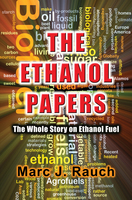WSJ Electric Vehicle Editorial Compares Napples and Noranges
 |
The question of electric being cleaner than gasoline is irrelevant if the goal is to save the world!
By Marc J. Rauch
Exec. Vice President/Co-Publisher
THE AUTO CHANNEL
 Marc Rauch |
Newfie jokes are like Polish jokes, or jokes about hillbillies, or like the jokes that Rush Limbaugh used to tell about people who live in Rio Linda, California. They're jokes about people who are humorously depicted to be of limited intellect. A Newfie is a person from Newfoundland, the eastern most province of Canada.
One Newfie joke goes like this:
-
Two Newfies (Clyde and Zeke) meet on a street one day and Zeke is carrying a bag. Clyde asks "What's in the bag?" Zeke says, "If you can guess
what's in the bag, You can have it. I'll give you a hint, it starts with the letter N."
Clyde ponders this for a moment, and then says "It's a Napple."
Zeke shakes his head and says, "No, it's a Norange!"
This is a two punchline joke. When told on stage by a skilled comedian (as I originally heard it nearly 50 years ago), the audience laughs at the first punchline "Napple." And the joke could be over at that point. But, the comedian went on to the second punchline about the mysterious object being a "Norange," and there was an even bigger laugh.
I selected this joke to start my reply to a Wall Street Journal editorial that compares electric powered vehicles against gasoline powered vehicles for two reasons. The first is because I wanted to make the point that the comparison is an Apples vs. Oranges comparison; and the second reason is because the researchers who were relied upon for the editorial's findings are from Canada.
The WSJ article was written by Russell Gold, with visual and data help from Jessica Kuronen and Elbert Wang. The editorial is titled "Are Electric Cars Really Better For The Environment?" It was published a few days ago, on March 22nd.
The "apples and oranges" comparison in the WSJ story is, obviously, electric versus gasoline. The comparison is irrelevant because an electric motor is very different than a gasoline internal combustion engine. An electric motor does not release or discharge any type of smoke (gas) or liquid during its normal operating process. A gasoline powered ICE can not operate without emitting some type of smoke. So the comparison is like asking if dirt is cleaner than no-dirt.
Of course, the overall issue is far greater than just the issue of emissions released into the atmosphere by an operating motor/engine. The question addressed by Mr. Gold and associates encompasses other aspects such as the manufacturing of the electric motors and vehicles, the manufacturing of the gasoline engines and vehicles, and the fuels used to produce the electricity that powers the electric motors.
The bottom line to the story is that in the long run electric powered vehicles are cleaner than gasoline powered vehicles. They point out that initially gasoline powered vehicles are cleaner, and that up to about 20,000 miles (a little less than 2 years of average driving) they are an even match. As the vehicles get used more and more, the electric vehicles come out as being much cleaner. This is really no surprise, and so one wonders why the authors and the Wall Street Journal would even bother with this story.
This question is answered by the backdrop, if you will, of the storyline. The backdrop is the 2015 Paris Agreement to keep global temperatures from rising. The WSJ editorial doesn't consider the more 'mundane' aspects of respiratory or brain-impairment problems caused by gasoline and its burning, nor does the editorial consider the human issues related to the use of slave-like and child labor to mine some of the minerals that are required to produce the batteries used by electric vehicles. This is an intriguing omission considering that the horrendous notion of health damage or using slave labor and child labor would be sufficient alone to derail most other production processes. It's almost as if it's okay to subject adults and children to bad health or slave-like working conditions if it helps the Chinese make lithium batteries. After all, there are slave camps in China, and they eat dogs, so who cares what Communist China does to people in Africa!
But hey, the point of my story, this article, isn't to focus on the societal differences in eating hot dogs (frankfurters) or eating real living dogs. The point of my story is the argument of electric powered vehicles versus gasoline powered vehicles. So with this in mind, let me get to it.
The authors and the Canadian researchers don't identify what type of gasoline they used in their study. Was it E0 gasoline or an ethanol-gasoline blend? I ask this because there is a pretty good difference between them when considering emissions, and because Canada has not had the same kind of biofuel mandates as America. Therefore, it's quite possible that they didn't use statistics related to any kind of ethanol-gasoline blend.
If it was a blend, what was the blend? Was it the E5 blend that was used for a number of years in Canada, or the more recently accepted E10. It's highly unlikely that they would have made their measurements against E15, which hasn't even really been put to use in America. And, if the authors and researchers are projecting into the future of electric vehicle acceptance and use (as they did), why didn't they do the same to project what would be the comparative difference between electric vehicles and vehicles powered by a future of E85 or E90 or E95 (as used in Brazil)?
Assuming that the University of Toronto researchers used E0 gasoline (or even E10), E85 is much, much cleaner; ostensibly up to eight times cleaner. If the U.S. Federal government, and state governments like California, decreed the use of at least E85 fuel to be used in all ICE vehicles (as they are basically doing regarding new electric powered vehicles), then internal combustion engine vehicles wouldn't be cleaner than electric vehicles just up to 20,000 miles, they might be cleaner - or at least equally clean - for 8 times more miles of usage. That's an entirely different story. So why wasn't that story told by WSJ? Why wasn't it at least hinted at?
If an internal combustion engine vehicle powered by E85, or a higher ethanol fuel, is as clean or cleaner than an electric vehicle for eight times longer than E0 or E10, then it means that the average "clean" E85 vehicle could be on the road for 8 times more than the 20,000 miles; in other words, something close to 15 years.
What makes knowing this so important - so crucially important if following the Paris Agreement means anything - is that a rather simple adjustment of mandating the use of higher ethanol fuels could be made by tonight....that is, if the future of planet Earth is so important. No need to wait until 2025, or 2035, or 2050 to stop the scourge of increasing global temperatures, and reduce further respiratory and brain development damage in humans, we could do it now. And when the time comes for the world to switch to electric vehicles, if it ever really comes, then we would already be safe and clean.
EPILOGUE: Two guys meet again on the street, Charlie and Zach. Charlie is carrying a bag labeled "From Paris."
Zach says, "If you give me a hint, I bet I can guess what you're carrying."
Charlie says, Okay, it starts with the letter B.
Zach excitedly responds, "Je sais, c'est Brioche!"
"Non" says Charlie, "c'est des conneries!"
(This erudite Charlie and Zack aren't from Newfoundland or Rio Linda, they're from Brooklyn. Check Google translator
to translate the French to English.)
 |
Would you like to learn more about ethanol? How about a 600-page book that you can read online for FREE? CLICK HERE to read it.


